Flower
Category : 11th Class
It can be defined as modified dwarf shoot which is meant for sexual reproduction. It is characteristic feature of angiosperm.
Parts of a typical flower : A typical flower of an angiosperm consists of four types of floral parts namely calyx, corolla, androecium and gynoecium.
General description of a flower
The flowers are termed pedicellate if they possess stalks and sessile if they lack them. The flower may be described as complete if it bears all the floral parts and incomplete, when one or more floral parts are absent. Flowers are called bisexual if they bear both androecium and gynoecium. The unisexual flowers have either androecium or gynoecium. The unisexual flowers may be male flowers or female flowers. The male flower are also called staminate flowers as they have stamens only.
The female flowers have only the carpels and hence called pistillate flowers. Flowers with sterile sex organs are described as neutral flowers. According to the distribution of male, female and bisexual flowers, various patterns are recognized.
Monoecious : Presence of male and female flowers on the same plant, e.g., Acalypha, Cocos and Ricinus.
Dioecious : Presence of male and female flowers on different plants, namely, male plants and female plants. e.g., Cycas, Carica papaya and Vallisneria.
Polygamous : Presence of unisexual and bisexual flowers on the same plant, e.g., Mangifera and Polygonum.
Symmetry of flower
The number, shape, size and arrangement of floral organs in a flower determines its symmetry. On the basis of symmetry flowers can be of the following types :
Actinomorphic (Regular = Symmetrical) : Actinomorphic flowers can be divided (passing through center) by any vertical plane into two equal and similar halves. e.g., Mustard, Brinjal, Catharanthus roseus.
Zygomorphic (Monosymmetrical) : Zygomorphic flowers can be divided into two equal halves by only one vertical division e.g., Pea, Larkspur, Ocimum.
Asymmetrical (Irregular) : Asymmetrical flowers can not be divided into two equal halves by any vertical division. e.g., Canna, Orchids.
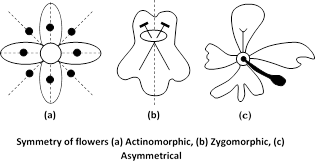
Arrangement of floral organs
On the basis of arrangement of floral organs, three types of flowers are recognized. They are :
Acyclic : Here the thalamus is conical or convex and the floral parts are spirally arranged, e.g., Water lily and Magnolia.
Cyclic : Here the floral organs are arranged in regular whorls at the nodes of the thalamus, e.g., Hibiscus and Datura.
Hemicyclic (Spirocyclic) : Here some floral parts (sepals and petals) are arranged in regular whorls and the remaining parts (stamens and carpels) are arranged spirally. e.g., Annona and Polyalthia.
Number of floral parts in whorl is called the merosity. There are two kinds of flowers based on the merosity of the flower. They are isomerous flowers and anisomerous flowers.
If the number of sepals, petals, stamens and carpels of flower is equal, such flowers are called isomerous flowers.
Dimerous : Two floral parts in each whorl. e.g., Poppy flower.
Trimerous : Three floral parts in each whorl. e.g., Monocot flowers (Liliaceae).
Tetramerous : Four floral parts in each whorl. e.g., Mustard.
Pentamerous : Five floral parts in each whorl. e.g., Solanum.
Detailed structure of flower
Angiospermic flowers exhibit many variations in their external morphological characters.
(1) Bract : Bract (hypsophyll) is a small leaf like structure on the peduncle which produces a flower in its axil. The floral buds are usually protected by the bracts.
Flower with a bract is described as bracteate and the flower without a bract is known as ebracteate. Bracteoles are small scale like structures present on the pedicel. Bracts are modified into following structures :
Foliaceous bract : Leaf like, expanded green bract is called the foliaceous bract, e.g., Pisum, Lathyrus, Adhatoda and Gynandropsis.
Spathe : A large modified bract which encloses spadix inflorescence totally or partially. It may be leathery or woody, e.g., Alocasia, Cocoa, Musa and Typhonium.
Petaloid bract : Brightly coloured petal like bract is known as petaloid bract, e.g., Bougainvillea, Poinsettia and Euphorbia.
Involucre : One or more whorls of green bracts that protect young inflorescence is called involucre, e.g., Coriandrum, Tagetes and Heracleum.
Epicalyx : Whorl of bracteoles present below the calyx or outside the calyx, e.g., Hibiscus rosa sinensis and Malvaviscus arborcus.
Scaly bracts : Reduced, membranous, scale like bracts seen in head inflorescence, e.g., florets in Tridax and Helianthus.
Glumes : The bracts found on the rachilla of spikelet are called glumes. They may be sterile glumes or fertile glumes (lemma), e.g., Oryza sativa.
(2) Thalamus : The terminal part of the pedicel is called thalamus or torus or receptacle. It is a condensed axis of the flower from which all floral parts arise. Depending upon the position of gynoecium on the thalamus with respect to other parts, flowers are of three kinds – hypogynous, perigynous and epigynous.
In many flowers, the thalamus is condensed and the internodes are not seen clearly. But there are some flowers with elongated, distinct floral internodes as mentioned below :
Anthophore : This is the first elongated internode between the calyx and corolla, e.g., Silene, Pennsylvania and Lychnis.
Androphore : It is the second elongated internode between corolla and androecium, e.g., Gynandropsis.
Gynophore : It is the third elongated internode between androecium and gynoecium e.g., Capparis and Gynandropsis.

Gynandrophore : It is an elongated stalk like part between non essential and essential organs of the flower. It is equivalent to androphore, e.g., Passiflora.
Carpophore : This is a stalk like connection present between two carpels. It is formed due to expansion of the thalamus between the carpels, e.g., Coriandrum and Foeniculum.
(3) Perianth : The non essential organs, calyx and corolla are together called perianth. The perianth protects the stamens and carpels. In angiospermic flowers, the perianth exists in different forms.
Achlamydeous : Perianth is absent and the flowers appear naked. Mostly the achlamydeous flowers occur in cyathium inflorescence. e.g., Euphorbia, Poinsettia.
Chlamydeous : Perianth is present and the flowers usually appear attractive. The chlamydeous flowers are of two types. They are :
Monochlamydeous flowers are with perianth in one whorl, e.g., Amaranthus and Ricinus.
Dichlamydeous flowers are with perianth differentiated into calyx and corolla. They are arranged in two different whorls. The dichlamydeous condition is of two types :
Homochlamydeous : The two whorl or the perianth (calyx and corolla) are similar in all respects and are not identified by different colours, e.g., Michelia.
Heterochlamydeous : The two whorls of the perianth are dissimilar in many respects. The outer whorl consists of small, green sepals and the inner whorl with large variously coloured petals, e.g., Datura and Hibisus. The term “tepals” is used to describe the perianth units when both sepals and petals are similar. e.g., most of the monocots.
(4) Calyx : It is the outermost whorl of the flower. It consists of sepals. Usually, the sepals are small and green. They protect other floral organs when the flower is in bud condition. The calyx is described as polysepalous when the sepals are free (e.g., Anona, Tomato) and gamosepalous when the sepals are united (e.g., Datura and Hibiscus). If sepals are fused less than half of the length of calyx tube it is called as partite and if the fusion of sepals is very little, just at the base of calyx tube, it is said to be connate. The sepals may be deciduous or persistent.
Usually the persistent calyx do not show any growth after fertilization. Such a calyx is termed as marcescent (e.g., Brinjal, Chilies). Sometimes the persistent calyx shows continuous growth even after, fertilization. This type of calyx called acrescent (e.g., Physalis and Shorea).
In some plants a whorl of green sepals like structure is present at the base of calyx called epicalyx. Epicalyx is considered a whorl of the bracteoles and mostly found in the flowers of family Malvaceae (Althaea, Cotton). The calyx may show number of modifications. They are :
Campanulate : Bell shaped, e.g., Althaea.
Cupulate : Cup like, e.g., Gossypium.
Urceolate : Urn shaped, e.g., Hyoscyamus.
Infundibuliform : Funnel shaped, e.g., Atropa belladona.
Tubular : Calyx tube like, e.g., Datura.
Bilabiate : Calyx forms two lips, e.g., Ocimum.
Spurred : One or two sepals forming a beak like structure, e.g., Larkspur.
Pappus : Calyx are modified into hairs e.g., Sonchus, Tridax (Asteraceae).
Spinous : When calyx forms spines, e.g., Trapa.
Hooded : When sepals enlarged to form a hood over the flower, e.g., Aconitum.
Petaloid : Enlarged and brightly coloured sepals, e.g., Clerodendron, Mussaenda, Sterculia, Caesalpinia and Saraca.
(5) Corolla : It is the second whorl of the flower consisting of petals. Usually the petals are brightly coloured and scented. They attract the insects which act as agents for pollination. The corolla may be polypetalous (with free petals), gamopetalous (with united petals) or apetalous (without petals). The corolla may undergo modifications or possess some special appendages.
Sepaloid : Green or dull coloured sepals. e.g., Anona, Polyalthia and Artabotrys.
Saccate : The corolla tube may form a pouch on one side. e.g., Antirrhinum.
Spurred : Sometimes one or two petals or the entire corolla tube grow downwards forming a spur that usually stores nectar. e.g., Aquilegia vulgaris.
Corona : Special appendages of different kinds like scales, hairs develop from the corolla. Such appendages are called corona. e.g., Passiflora, Oleander and Nerium.
Forms of corolla : Both polypetalous and gamopetalous corolla exhibit great variation in their forms. It is of following types :
(i) Polypetalous corolla : They are of following types :
Cruciform : Four free clawed petals arranged in the form of a cross, e.g., Mustard and Radish.
Rosaceous : Five free sessile petals with lobes spreading outwards, e.g., Rose, Hibiscus.
Caryophyllaceous : Five free clawed petals with limbs at right angles to the claw, e.g., Dianthus.
Papilionaceous : Five free unequal petals arranged in definite fashion. The posterior petal is the largest and is called standard or vexillum. On either side of the standard, two lateral petals called wings are present. The remaining two anterior petals unite to form a boat shaped structure called the keel. e.g., plants of family papilionaceae.
(ii) Gamopetalous corolla : They are of following types :
Tubular : Five united petals form a cylindrical tubular structure, e.g., disc florets of Asteraceae.
Infundibuliform : It is a funnel shaped corolla, e.g., Datura.
Campanulate : It is bell shaped corolla, e.g., Thevetia.
Rotate : Short tubular corolla with spread out lobes appearing like a wheel e.g., Brinjal.
Hypocrateriform : It is a salver shaped corolla. It is provided with a elongated narrow tube having lobes at the top placed at right angles, e.g., Vinca.
Ligulate : Corolla with a short tube which is drawn out into a tongue shaped structure e.g., ray florets of Asteraceae.
Bilabiate : The irregular corolla is united, in such a way that it appears two lipped. It is the characteristic corolla of labiatae, e.g., Leucas.
(6) Aestivation : The arrangement of sepals and petals in bud condition of the flower is called “aestivation”. It may be of following types :
Open : If the margins of perianth members in a whorl are free with wide gap between them, then the type of aestivation is called ‘open’, e.g., sepals of Mustard.
Valvate : Here the edges of perianth members in a whorl are very nearly touching each other but do not overlap, e.g., calyx and corolla in Annona.
Twisted : In this type, the perianth members of a whorl show one edge outside and one edge inside. Thus they regularly overlap the neighbouring members on one side. The twisted aestivation is also called contorted or convolute aestivation, e.g., corolla of Hibiscus.
Imbricate : Here in a whorl of perianth members, one is completely inside and another is completely outside. The remaining perianth members show one edge inside and the other edge outside. The imbricate aestivation is of two types, namely, descending imbricate and ascending imbricate.
Descending imbricate : Here the odd petal is posterior and completely outside. The anterior pair of petals are completely inside. The remaining petals show regular overlapping in the descending manner. e.g., Tephrosia, Crotalaria and Dolichos.
Ascending imbricate : Here the odd petal is posterior and completely inside. One of the anterior petals is completely outside. The remaining petals show regular overlapping in ascending manner, e.g., Cassia and Delonix.
Quincuncial : In this type, out of the five perianth members in a whorl two are completely outside, two are completely inside and the remaining has one edge outside and one-edge inside. This is confined to pentamerous flowers only, e.g., sepals of Ipomoea, Vinca and Thevetia.
Vexillary : Same as papilionaceous corolla.
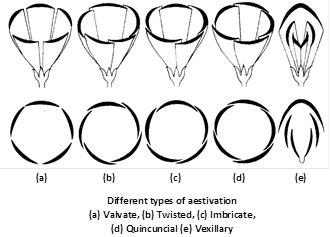
(7) Androecium or Stamens : It is the third whorl of a flower consisting of stamens or microsporophylls. Fertile stamens produce pollen grains. Staminodes are the sterile stamens. Petaloid stamens are brightly coloured and appear like petals, e.g., Canna.
(i) Structure of stamen : A stamen shows a long or short stalk called the filament. The filament ends with a terminal fertile part known as the anther. It encloses microsporangia within which microspores or pollen grains are produced. The filament of the stamen is connected to the anther by means of a “connective”. The anther may be monothecous or dithecous. The monothecous anther has only one sac. It is bilocular or bisporangiate, e.g., Hibiscus. The dithecous anther consists of two sacs and is tetralocular or tetrasporangiate as in Datura.
When the face of anther is towards centre of flower it is called introrse e.g., tomato when it is towards the periphery it is called extrorse e.g., Ranunculus.
(ii) Fixation : The mode of attachment of a filament to anther by connective is called fixation. It is of following types :
Adnate : Filament attached to the total length of the anther on the back. e.g., Michelia (Champa).
Basifixed : Filament is attached to the base of the anther e.g., Datura, Mustard, Radish.
Dorsifixed : Filament is attached to the anther on the dorsal side at middle portion e.g., Passiflora.
Versatile : Filament is attached to the anther at a point so that anther can swing freely in all direction. e.g., Grasses.
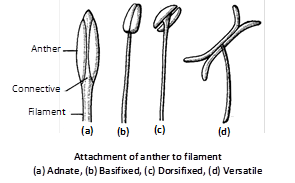
(iii) Length of stamens : Based on the relative lengths of the stamens, the conditions of androecium varies :
Didynamous : When there are four stamens in a flower of which two are long and two are short, the condition is described as didynamous, e.g., Ocimum.
Tetradynamous : Out of the six stamens that are found in a flower, four stamens are long and the two are short. This condition is called tetradynamous, e.g., Raphanus and Brassica.
The stamens are described as inserted when they do not extend beyond the petals or corolla tube (Dolichos). When the stamens extend beyond the petals or corolla tube, the stamens are known as exserted (Acacia).
(iv) Insertion of stamens : Based on the insertion of stamens, the condition of androecium varies :
Isostemonous : When the stamens form a single whorls and the number of stamen is the same as that of sepals and petals, the flower is isostemonous. e.g., Solanum.
Diplostemonous : Sometimes there are two whorls of stamens. The first whorl alternating with petals (antisepalous) and the second whorl alternating with sepals (antipetalous). e.g., Cassia.
Obdiplostemonous : In this condition first whorl is antipetalous and the second whorl is antisepalous. e.g., Dianthus.
(v) Union of stamens : The union of stamens takes place either among themselves (cohesion) or with other whorls (adhesion).
Cohesion of stamen : Usually following types of cohesion among stamens occur. They are :
Adelphous : When the filaments of stamens are united and the anthers remain free. It is of three types :
Monoadelphous : All filaments unite to form a single bundle e.g., Family malvaceae (Hibiscus).
Diadelphous : Filaments unite to form two bundles. e.g., Family papilionaceae (Pisum, Sesbania, Tephrosia).
Polyadelphous : Filaments unite to form many bundles. e.g., Family rutaceae (Citrus, Melaleuca).
Syngenesious : When the anther of filament are united and the filaments remain free. e.g., Tridax, Sunflower etc.
Synandrous : Here all stamens of a flower are united completely to form a single structure. e.g., Family Cucurbitaceae.
Adhesion of stamens : Stamens may unite with other floral organs like sepals, petals or gynoecium. Based on the floral organ involved in the union with stamens, the adhesion may be of the following types :
Epiphyllous : Stamens unite with perianth. e.g., Onion.
Episepalous : Stamens unite with sepals. e.g., Prunus (Peach).
Epipetalous : Stamens unite with petals. e.g., Datura.
Gynandrous : Stamens unite with gynoecium. It is also called gynandrium or gynostegium. e.g., Calotropis.
(8) Gynoecium or Carpels : The gynoecium or pistil is the fourth essential whorl of female reproductive part of the flower and may be made up of one or more carpels (megasporophylls). A carpel has three distinct part, namely ovary, style and stigma.
The lower most swollen fertile part of the carpel is the ovary. It encloses ovules. A sterile pistil is known pistillode. The number of carpels is a gynoecium varies in different flowers.
Monocarpellary : It is a gynoecium with a single carpel, e.g., Bean.
Bicarpellary : It is presence of two carpels in a gynoecium. e.g., Helianthus.
Tricarpellary : It is presence of three carpels in a gynoecium e.g., Cocos.
Tetracarpellary : It is presence of four carpels in a gynoecium. e.g., Cotton.
Pentacarpellary : It is presence of five carpels in a gynoecium. e.g., Hibiscus.
Multicarpellary : It is presence of many carpels in a gynoecium. e.g., Annona.
The ovary encloses one to many chambers called the locules. Based on the number of locules, the ovary may be described as follows :
Unilocular : Ovary with one locule. e.g., Dolichos.
Bilocular : Ovary with two locules. e.g., Solanum.
Trilocular : Ovary with three locules. e.g., Allium.
Tetralocular : Ovary with four locules. e.g., Datura.
Pentalocular : Ovary with five locules. e.g., Hibiscus.
Multilocular : Ovary with many locules. e.g., Abutilon.
(9) Style : The stalk like structure present above the ovary is called the style. The style may be long (Datura) or short (grasses) or absent (Papaver). In the family umbelliferae (apiaceae) the base of the style is swollen and forms a structure called stylopodium. There are three types of styles as described below :
(i) Terminal style : If the style arises from terminal part of the ovary, it is called terminal style, e.g., Datura, Hibiscus and Solanum.
(ii) Lateral style : If the style arises from one side of the ovary, it is called lateral style, e.g., Mango.
(iii) Gynobasic style : If the style arises from the base of the ovary it is called gynobasic style, e.g., Ocimum, Salvia.
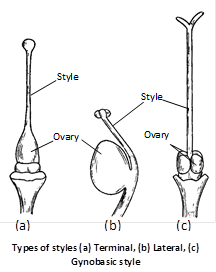
(10) Stigma : The terminal receptive portion of the style is called the stigma. It receives pollen grains during pollination. Usually the lobes of the stigma corresponds to the number of carpels. Accordingly the stigma may be unifid, bifid, trifid, tetrafid, pentafid or multifid.
Capitate : Round stigma. e.g., Hibiscus.
Forked : Divided stigma. e.g., Tridax.
Feathery : Brush like stigma. e.g., Grasses.
(11) Floral formula : It represents the informations given in a floral diagram in the form of an equation. Following symbols are used in constructing a floral formula.

(12) Floral diagram : Following signs are used in constructing a floral diagram.
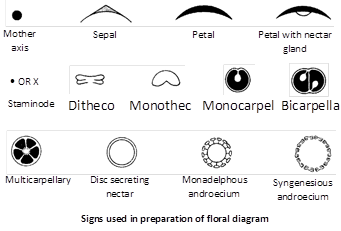
You need to login to perform this action.
You will be redirected in
3 sec
